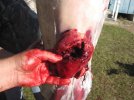KDSTRICK,
I'll start with the first item you wanted clarified....
What I really should have said is that it MAY cause immense physical pain, anything that is over the threshold of pain MAY have that effect. Once adrenaline is factored in, you may not feel anything but you will certainly not be able to hear if a 357 Magnum is fired in a confined space.
I've had a 45 ACP discharged VERY close to my head inside a friends Lexus.....not a pleasant experience as it was aimed at my head a split second before it went off!!
I had total loss of hearing for about 30 seconds after the discharge, and then my hearing slowly improved whilst I still have occasional ringing in my right ear.
I felt no pain though, which I attribute to the huge rush of adrenaline that came with staring down the barrel of a pistol.
SO, maybe you won't experience any pain but maybe you will?? There's a lot of variables involved in a dynamic situation like a self defense situation.
In regards to you second item.....
I've read the article that you posted, and I know that I am arguing this point against virtually every self defense teacher and law enforcement agency......BUT....
I stated that I personally do not believe in over-penetration, while I know that many folks consider anything over 12" of ballistic gel penetration to be too much.
Ballistic gelatin is not a living breathing human being, and it can only give you so much information.
The human body has most of it's vital organs surrounded by bone, in order to protect the vitals with in essence armor plating.
Ballistic gel does not take this into account, nor does it take intermediate barriers into account such as sheet metal, glass, wood, drywall.
This being the case, I will take more penetration....and deal with any legal action once I've survived the ordeal.
My statement was that Flat points CAN do more damage than Hollow points.
It has been proven that wide meplat flat points crush tissue. The only cavity that matter in wounding is the permanent crush cavity, it matters not how big the temporary stretch cavity is because human tissue is extremely elastic and it will stretch right back without being torn or crushed.
A flat point will undoubtedly cause a wider wound diameter than it's original caliber diameter because of this principle.
The vast majority of hollow points are very slow to expand, even if they do increase by twice their original diameter.
The only exception to this rule is the Barnes X-Bullet, which expands very early in it's penetration.
If you look at the diagram you posted, notice the permanent crush cavity is largest at the beginning of the penetration.
This is because of loss of velocity due to the parachute effect of an expanded bullet, which causes a not so great wound channel for the latter half of penetration.
A Flat point will have a more uniform wound channel and it should be of similar diameter as the entrance wounds you have diagramed.
Here's a photo and quote take from another forum...

"This wound was made by a 45 Colt at 1150 FPS muzzle velocity shooting a flat point hard cast bullet with a .360 meplat
This is what the wound channel calculator predicts
Wound channel diameter of 0.99" with a bullet with a meplat diameter of .360", and a striking velocity of 1100 fps.
Seems rather realistic to me. Those that do not believe that a wide meplat hard cast bullet leave large wound channels are very naive and inexperienced in my experience
Penetration is your friend and wide meplat hard cast bullet provide penetration and large wound channels in spades."
and another quote:
"No penetration no hole, no hole = no effectiveness
One must consider angles and barriers when deciding on the amount of penetration needed in a lethal confrontation. Penetration is always your friend, lack there of can get you killed."
Sorry if I wrote a short novel in this post, but I hope this helps clarify my thoughts on the matter. YMMV.


